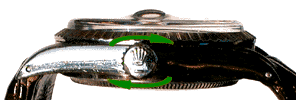Owners's Guide to Fine Wristwatches
Answers to everyday questions about operating mechanical, automatic and quartz watches
- How do I manually wind the watch enough without overwinding it?
- Which way do I turn the crown to wind the watch?
- How do I operate and how much should I tighten the screw-down crown?
- Is it okay to leave my chronograph function running all the time?
- When I set my watch, is it okay to roll the time backwards?
For troubleshooting tips, see: General Wristwatch Troubleshooter
How do I manually wind the watch enough without overwinding it?
Manual-wind watches normally give you feedback when they are sufficiently wound by offering
resistance at the crown. Never attempt to wind more after you start to feel this resistance--you
can severely damage the watch.
Automatic watches operate quite differently. Since they have the capability of winding
themselves, they also need protection against overwinding. So all automatic watches are
equipped with a gear that disengages when the spring is fully wound. The advantage is that
it makes it impossible to manually overwind an automatic watch. The disadvantage is that you
loose the feedback of when you have wound your automatic watch enough.
Generally, mechanical watches take somewhere in the range of 20 to 30 turns of the crown
to wind them fully from being completely run down.
Which way do I turn the crown to wind the watch?
 Almost all mechanical watches wind by turning the crown clockwise (if you are looking straight at the
logo on the crown). When you are looking at the face of the watch, this means rotating the upper face
of the crown upwards, toward the 12.
Almost all mechanical watches wind by turning the crown clockwise (if you are looking straight at the
logo on the crown). When you are looking at the face of the watch, this means rotating the upper face
of the crown upwards, toward the 12.
Most watches are perfectly accomodating in allowing you to turn the crown the other way too,
but the reverse direction is simply a neutral gear mode which does not wind the watch. Some people prefer
to turn the crown back-and-forth without taking their fingers off of it. Other people rotate it forward,
reposition their fingers, then rotate forward again. Both are equally valid and effective ways of winding
a watch
How do I operate and how much should I tighten the screw-down crown?
Many watches that are highly water-resistant have screw-down crowns. Essentially, the crown of the watch
(the knob on the side used to wind and set the watch) screws in place like a tiny bottle cap to make sure
that part of the watch is extra water-resistant.
To open the crown, simply turn the crown anti-clockwise to unscrew it (takes about 4 or 5 turns).
To close it back, push it in while turning clockwise. Do not close it real tight, just with mildly firm
finger pressure. It is the threading that provides water-tightness, so over tightening does nothing to
increase the water protection and can overstress the metal, eventually damaging it and ruining the water
protection of the crown.
A few diving watches also have a "helium relief valve." If yours does, check that it is closed similarly.
Once the crown is unscrewed and in the "neutral" position, the crown operates like any normal watch.
Is it okay to leave my chronograph function running all the time?
On most mechanical chronographs, yes it is okay. Some people prefer to do this in order to have the
large second hand running. There is no evidence this causes any additional wear of any significance to
the watch. It also makes little difference in the power reserve on your mechanical watch. Omega reports
that their watches should lose less than 2% of their power reserve having the chronograph running continiously.
On quartz chronographs it is certainly okay. Though some quartz chronographs may limit the duration
that the chronograph will run. Also, some quartz watches may disable the chronograph functions to
conserve battery power when the battery is very low.
When I set my watch, is it okay to roll the time backwards?
As a general practice, no for mechanical watches, yes with some limitations for quartz watches.
For some watches with mechanical movements, this is a bad idea for several reasons. First, the
mechanisms are usually designed around moving forward, so some cannot take the stress of reversing
properly. Second, after a mechanical watch settles in, reversing the watch against the pattern of
wear may cause unnecessary additional wear.
Both mechanical and quartz watches with dates and other complications handled by mechanical parts
can be harmed by rolling the time backwards--especially near midnight.
Despite that, many modern watches can be reversed with no problem. But it is best to check
with the manufacturer to be sure. The one general rule is that if your mechanical watch's second hand
does not stop when you put the watch in time setting mode, then you should definitely not turn the
hands backwards.
The types of watches where it never matters to turn the time backwards are quartz watches where
neither the date window nor the hands are moved directly by the crown. Two examples are the Breitling
Aerospace and Omega Seamaster Multifunction. On both of these, the date appears on a digital display
and the hands are moved forward or backwards electronically by commands issued by rotating the crown.
|